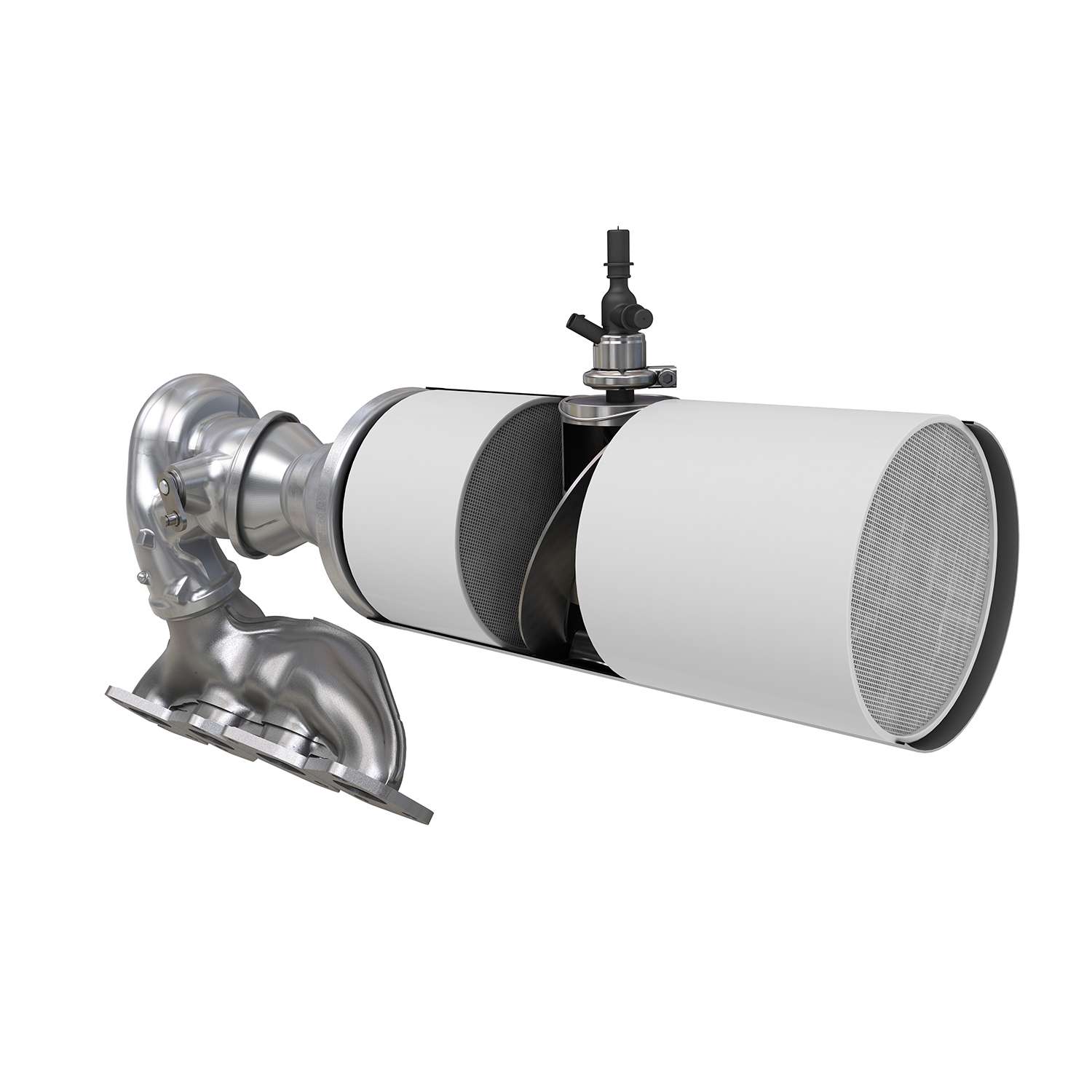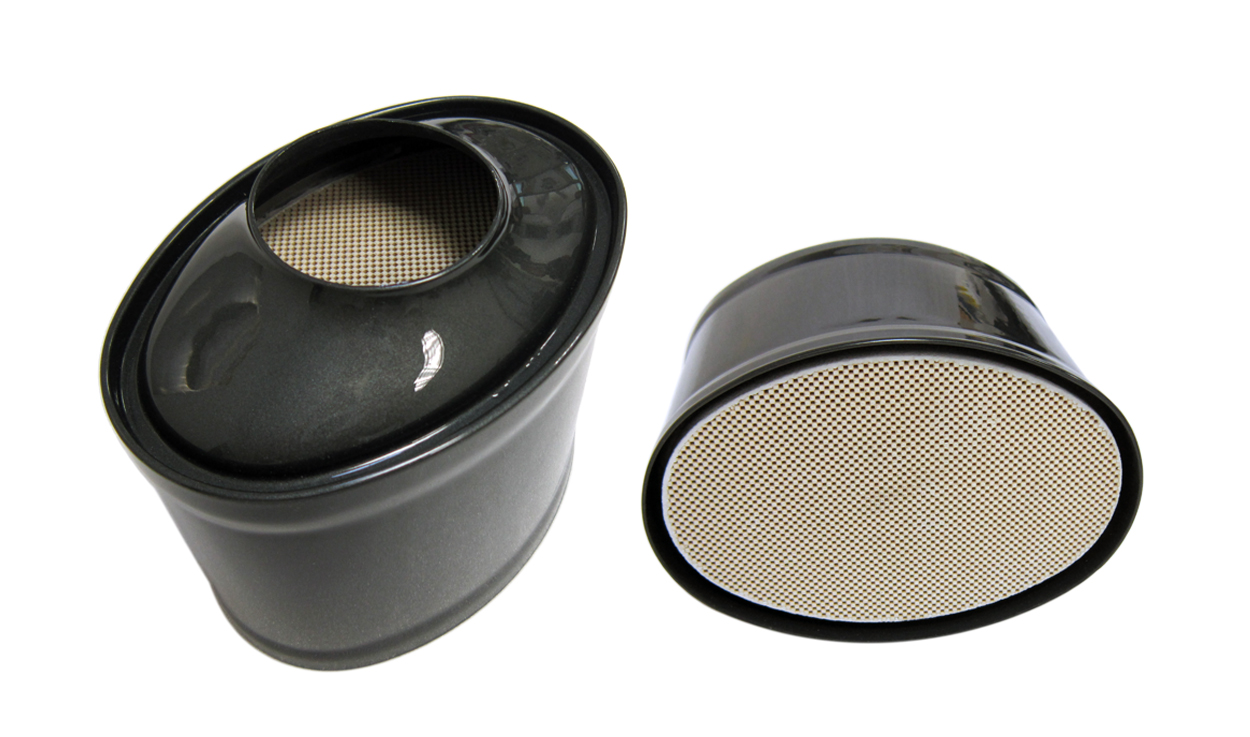 天纳克公司的双涡流混合器专为Euro 6c柴油后处理标准设计。
天纳克公司的双涡流混合器专为Euro 6c柴油后处理标准设计。 在这张双涡流混合器的剖面图中可以看到,尿素喷射在氧化催化剂和SDPF间的一个狭小空间内进行。
在这张双涡流混合器的剖面图中可以看到,尿素喷射在氧化催化剂和SDPF间的一个狭小空间内进行。 天纳克公司设计的椭圆形汽油颗粒过滤器不仅适用于狭小空间的封装,还能满足Euro 6c的要求。
天纳克公司设计的椭圆形汽油颗粒过滤器不仅适用于狭小空间的封装,还能满足Euro 6c的要求。
2017年9月,Euro 6c轻型发动机排放限值规定正式出台后,无论是汽油机还是柴油机都将面临一系列挑战。其中的一个重要难题就是要求柴油发动机的选择性催化还原(SCR)催化剂加快起燃速度。
在当前的系统中,一台柴油机的SCR催化剂需要花费10-12分钟才能达到起燃温度。这在很大程度上是由尾气后处理系统的封装所决定的。
在当前的Euro 6b体系中,柴油颗粒捕集器(DPF)可能是发动机下游的第一台后处理设备,DPF的尾端和SCR催化剂的前端之间相隔50-60 cm(19.6 – 23.6英寸)。而Euro 6c则规定起燃时间必须缩减至3-4分钟。不仅是Euro 6c,美国的Tier 3法规也同样如此规定,甚至要求起燃必须在2分钟或更短的时间内解决。而将SCR和DPF之间的距离缩短至10 cm(4英寸)左右可能解决这一问题。
但这么做有一个问题,那就是无论是DPF还是SCR催化剂都距离发动机太远了,因此无法保证在要求的时间内达到要求的工作温度。在2015年IAA法兰克福车展上,天纳克公司公司提出了一种新的解决方案:将DPF和SCR合二为一,而具体做法则是为DPF涂上SCR催化剂。
双涡流技术
“我们把这个方案称为SDPF,也就是涂了SCR催化剂的DPF,”天纳克公司清洁空气公司高级工程与热端研发核心科学执行主任Frank Terres解释道。
“如果你想把SCR和DPF合并起来,你还需要把投加点移到柴油氧化催化剂(DOC)和SDPF中间的缝隙那里,” Terres指出。“通常这两片基质中间有1 cm的缝隙,但现在因为你得在这个小缝里面加料,所以缝隙必须扩大。在封装的限制下,扩大1 cm都很困难。你扩大了几厘米,可能不到10cm,接着注射尿素添加剂的整个流程都需要在小洞里完成。”
这个流程包括注射、氧化、蒸发、水解尿素并将其转化成氨,并在SDPF上均匀涂抹。Terres承认这的确不简单。
为了在这么小的一片空间里将尿素溶液和尾气混合,天纳克公司公司开发出了一种解决方案:全新的双涡流系统。该系统有助于促进上述物质的混合,即便混合空间如SDPF般狭小。
“我们可以制造一段涡流,同时喷射尿素,接着用缸壁来控制液滴的接触,而液滴会在缸壁上蒸发,”他解释道。
除了冷启动状态下必须缩短起燃时间外,新的欧洲真实驾驶排放(RDE)测试还提出了另一些要求。“你的系统必须在所有的实际驾驶情况中运行,”Terres指出。针对该要求,天纳克公司将尿素喷射器放在了催化剂系统中一个温度高得多的位置上。
此外,天纳克公司还采用将尿素从缸体流向喷射器和后部的方法来冷却喷射器。通过这种方法,无论尾气系统的环境温度升得多高,喷射器中的尿素温度都能维持在40ºC (104ºF)左右。
设计DOC和SDPF的串联系统需要足够大的空间,因此只能设计一种平行系统。也就是说,需要将柴油氧化催化剂和涡轮增压器直接相连,再将SDPF与其平行放置。一个台阶型的混合器可以提供与串联系统混合器相同的功能。
全新的椭圆形GPF可塞进狭小空间
另外,天纳克公司还在法兰克福车展上展出了专为Euro 6c设计的椭圆形的汽油颗粒捕集器(GPF),Euro 6c规定了2017年9月1日之后直喷汽油发动机的颗粒数量。此外,Euro 6c还将规定一项全新的测试循环,适用于欧盟所有的发动机测试。天纳克公司专门为此设计了一款椭圆形GPF,使其得以嵌入柱形GPF无法进入的地方。
“我们碰到的难题是,在GPF中使用的基质的洞孔比柴油过滤器更多,因此它们更加脆弱,”Terres表示。“这使得整个封装流程特别困难。”
天纳克公司技术、战略和商务发展副总裁Tim Jackson阐述了GPF研发背后的思考。
“我们必须优化发动机的燃油经济性和CO2排放,在此基础上,再用成本划算的后处理系统来清理剩余的尾气,”他表示。“我们不能为了达到排放标准而牺牲CO2指标和燃油经济性。现在全球各地都面临着CO2减排的问题,因此我们的想法应该能得到更多共鸣。”
和柴油颗粒过滤器不同的是,GPF是一种可以自我再生的装置,只要达到特定温度便可再生。而且这种再生还是持续不断的。针对这种特性,天纳克公司发明了两种封装方法。该装置既可在现有的三元催化剂之外安装,也可以将三元催化剂涂在GPF的基材上,以形成天纳克公司所称的“四元催化剂”。
“由于这个过滤器的流动特性更好,气体污染物的转换效率更高,因此你可以缩小整体体积并节约一部分贵金属材料。” Frank Terres指出。
作者:John Kendall
来源:SAE《汽车工程杂志》
翻译:SAE上海办公室
Tenneco unveils emission-control solutions for Euro 6c
Euro 6c emissions limits will present a number of challenges for light duty engine emissions, both gasoline and diesel when the regulations come into force in September 2017. One significant hurdle is speeding light-off of diesel selective catalytic reduction (SCR) catalysts.
In current systems it can take up to 10 or 12 minutes for a diesel SCR cat to reach its light-off temperature. This is determined to an extent by the packaging of the exhaust aftertreatment system.
In a current Euro 6b system the diesel particulate filter (DPF) may be the first aftertreatment device downstream of the engine, with a separation of 50 to 60 cm (19.6 to 23.6 in) between the rear of the DPF and the front of the SCR cat. Under Euro 6c, the light-off time would have to be shortened to between three to four minutes. The same will apply to US Tier 3 regulations, which will require a light off time of two minutes or less. Reducing the distance between the SCR and DPF to around 10 cm (4 in) could help.
The problem then is that neither the DPF nor the SCR cat is close enough to the engine to ensure that both have reached the required working temperature in the required time interval. Tenneco’s solution, on display at the 2015 IAA Frankfurt Show, is to combine the two devices in one. In this case the DPF is treated with an SCR coating.
Double-swirl does it
“That is what we call an SDPF, an SCR coated DPF”, explains Frank Terres, Executive Director, Core Science, Advanced Engineering and Hot End Development, Tenneco Clean Air.
“If you move the SCR portion into the DPF, you also need to move the dosing point to the gap between the diesel oxidation cat (DOC) and the SDPF," noted Terres. "Normally there is 1 cm between those two substrates but now you need to increase this gap because you need to dose in this small gap. Every centimeter is a pain because you have package constraints. So you give your few centimeters, maybe less than 10cm and the whole processing of the urea additive that you inject needs to be done in this small cavity."
Processing means injection, atomization, evaporation, hydrolysis and transforming into ammonia and then distributing everything homogeneously on the SDPF–a challenge, he admits.
Tenneco has developed a solution to the problem of mixing the urea solution with the exhaust gases in such a small space. The company’s new double swirl system is able to promote the mixing even in a very compact mixing zone such as in the SDPF.
“We generate a swirl and inject the urea, then have a controlled contact of the fluid droplets with the wall, where they can evaporate,” he explained.
In addition to the shortened light-off time from a cold start, the new European Real Driving Emissions (RDE) test also presents challenges. “You need to have a system that performs under all realistic driving conditions,” Terres noted. The urea injector is positioned in a much hotter area of the catalyst system than on previous designs.
Tenneco also uses the urea supply to cool the injector by circulating the flow from the tank to the injector and back. This ensures that the urea temperature in the injector is around 40ºC (104ºF) despite the high surrounding temperature of the exhaust system.
There may be insufficient space for an in-line DOC/SDPF design. In this case some form of parallel design would be necessary. This might involve connecting the diesel oxidation catalyst directly to the turbocharger, with the SDPF in parallel to it. A step-shaped mixer offers the same functionality as the mixer in the in-line system.
New oval GPF fits tight spaces
Tenneco also launched its oval-shaped gasoline particulate filter (GPF) at Frankfurt, anticipating the EU Euro 6c regulations, which will introduce a particulate number standard for direct injection gasoline engines from 1 September 2017. Euro 6c will also introduce a new test cycle for all EU engine testing. The oval shape has been designed so that it can fit into spaces where a cylindrical shape might not fit.
“The challenge for us is that the substrates used in a GPF have a higher porosity than a diesel filter and as a result they are more fragile," said Terres. "That makes the whole canning process very challenging."
Tim Jackson, Tenneco's Executive Vice President Technology, Strategy and Business Development, explained the thinking behind the development of the GPF.
"Let’s optimize the engine for fuel economy and CO2 emissions and let’s use the affordable aftertreatment to clean up the remaining emissions," he said. "Let’s not sacrifice CO2 and fuel economy to meet criteria [emissions]. Now that all the continents are faced with CO2 reduction goals, I think that message resonates a little stronger.”
The GPF is a self-regenerating device, unlike diesel particulate filters, which need to reach a particular operating temperature for regeneration to take place. The GPF is a continuously regenerating device. Tenneco has devised two ways of packaging it. The unit can either be included in addition to the existing three-way catalyst or the three-way catalyst coating can be applied to the GPF substrate to form what Tenneco terms a four-way catalyst.
“Because of the better flow characteristics in this filter, the efficiency of the gaseous pollutants conversion is much better, so you could make the total volume smaller and reduce the amount of precious metals used," noted Frank Terres.
Author: John Kendall
Source: SAE Automotive Engineering Magazine
等级
打分
- 2分
- 4分
- 6分
- 8分
- 10分
平均分
